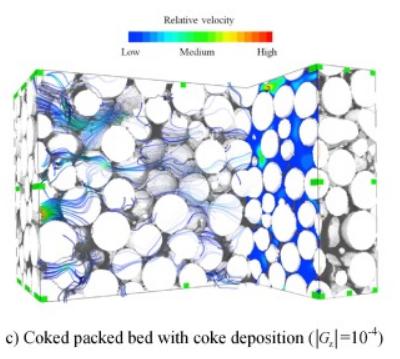Quantification of the microstructure, effective hydraulic radius and effective transport properties changed by the coke deposition during the crude oil in-situ combustion
Coke deposition during crude oil in-situ combustion (ISC) is an important phenomenon that significantly impacts the pore topology and permeability.

In this study, X-ray computed microtomography and a specific image processing procedure were used to reconstruct the micro-tomographic images of packed beds with coke deposition. From the reconstructed images, the microstructural parameters related to the transport were analyzed, such as the effective porosity, the constrictivity and the geodesic tortuosity. The Lattice Boltzmann method was used to simulate the species diffusion and fluid flow through the microstructures to quantify the mass diffusivity and permeability. The experimental work was performed to validate the digital microstructures and the simulated permeability. The effects of the coke deposition on the pore topology and the permeability were analyzed. The coke deposition pattern showed significant deposition in the pore throat. Analyses of the pore size distribution lead to a more reasonable geometric approach to measure the effective hydraulic radius for the better permeability prediction. Based on the effective transport properties and the microstructural parameters, a developed permeability relation was introduced by factorizing the permeability into two distinct contributions from the characteristic length and the microstructural effect. The permeability model describes the main influences of all the relevant geometric parameters on the permeability reduction by the coke deposition.